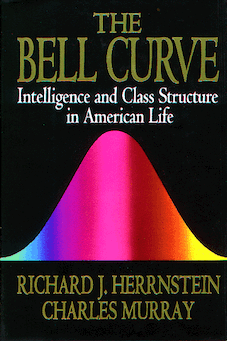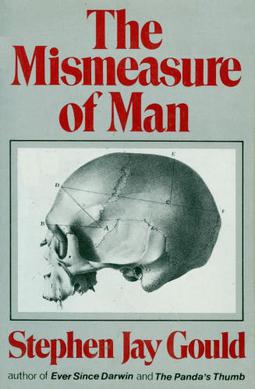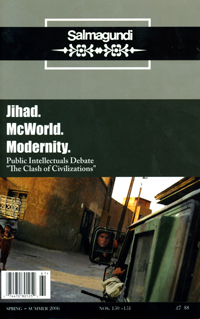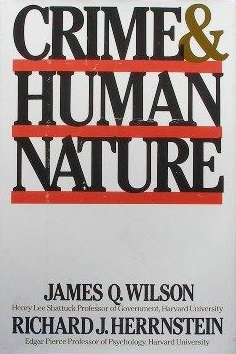
Arthur Robert Jensen was an American psychologist and writer. He was a professor of educational psychology at the University of California, Berkeley. Jensen was known for his work in psychometrics and differential psychology, the study of how and why individuals differ behaviorally from one another.
The bell curve is typical of the normal distribution.

The Bell Curve: Intelligence and Class Structure in American Life is a 1994 book by psychologist Richard J. Herrnstein and political scientist Charles Murray, in which the authors argue that human intelligence is substantially influenced by both inherited and environmental factors and that it is a better predictor of many personal outcomes, including financial income, job performance, birth out of wedlock, and involvement in crime than are an individual's parental socioeconomic status. They also argue that those with high intelligence, the "cognitive elite", are becoming separated from those of average and below-average intelligence, and that this separation is a source of social division within the United States.

The Mismeasure of Man is a 1981 book by paleontologist Stephen Jay Gould. The book is both a history and critique of the statistical methods and cultural motivations underlying biological determinism, the belief that "the social and economic differences between human groups—primarily races, classes, and sexes—arise from inherited, inborn distinctions and that society, in this sense, is an accurate reflection of biology".

Richard Julius Herrnstein was an American psychologist at Harvard University. He was an active researcher in animal learning in the Skinnerian tradition. Herrnstein was the Edgar Pierce Professor of Psychology until his death, and previously chaired the Harvard Department of Psychology for five years. With political scientist Charles Murray, he co-wrote The Bell Curve, a controversial 1994 book on human intelligence. He was one of the founders of the Society for Quantitative Analysis of Behavior.

Richard Lynn was a controversial English psychologist and self-described "scientific racist" who advocated for a genetic relationship between race and intelligence. He was a professor emeritus of psychology at Ulster University, but had the title withdrawn by the university in 2018. He was the editor-in-chief of Mankind Quarterly, which is commonly described as a white supremacist journal. Lynn was lecturer in psychology at the University of Exeter and professor of psychology at the Economic and Social Research Institute, Dublin, and at the University of Ulster at Coleraine.

Charles Alan Murray is an American political scientist. He is the W.H. Brady Scholar at the American Enterprise Institute, a conservative think tank in Washington, D.C.

Mankind Quarterly is a journal that has been described as a "cornerstone of the scientific racism establishment", a "white supremacist journal", and "a pseudo-scholarly outlet for promoting racial inequality". It covers physical and cultural anthropology, including human evolution, intelligence, ethnography, linguistics, mythology, archaeology, and biology. It is published by the Ulster Institute for Social Research, which was presided over by Richard Lynn until his death in 2023.
Hereditarianism is the doctrine or school of thought that heredity plays a significant role in determining human nature and character traits, such as intelligence and personality. Hereditarians believe in the power of genetics to explain human character traits and solve human social and political problems. Hereditarians adopt the view that an understanding of human evolution can extend the understanding of human nature.

John Clinton Loehlin was an American behaviorial geneticist, computer scientist, and psychologist. Loehlin served as president of the Behavior Genetics Association and of the Society of Multivariate Experimental Psychology. He was an ISIR lifetime achievement awardee.

Salmagundi is a US quarterly periodical, featuring cultural criticism, fiction, and poetry, along with transcripts of symposia and interviews with prominent writers and intellectuals. Susan Sontag, a longtime friend of the publication, referred to it as "simply my favorite little magazine." In The Book Wars, James Atlas writes that Salmagundi is "perhaps the country's leading journal of intellectual opinion."
Free Press was an American independent book publisher that later became an imprint of Simon & Schuster. It was one of the best-known publishers specializing in serious nonfiction, including path-breaking sociology books of the 1950s, 1960s and 1970s. After a period under new ownership in the 1980s of publishing neoconservative books, it was purchased by Simon & Schuster in 1994. By 2012, the imprint ceased to exist as a distinct entity; however, some books were still being published using the Free Press imprint.

"Mainstream Science on Intelligence" was a public statement issued by a group of researchers led by psychologist Linda Gottfredson. It was published originally in The Wall Street Journal on December 13, 1994, as a response to criticism of the book The Bell Curve by Richard Herrnstein and Charles Murray, which appeared earlier the same year. The statement defended Herrnstein and Murray's controversial claims about race and intelligence, including the claim that average intelligence quotient (IQ) differences between racial and ethnic groups may be at least partly genetic in origin. This view is now considered discredited by mainstream science.
Russell Jacoby is a professor of history at the University of California, Los Angeles (UCLA), an author and a critic of academic culture. His fields of interest are twentieth-century European and American intellectual and cultural history, specifically the history of intellectuals and education.

The g Factor: General Intelligence and Its Implications is a book by Christopher Brand, a psychologist and lecturer at the University of Edinburgh. It was published by John Wiley & Sons in the United Kingdom in March 1996. The book was "depublished" by the publishing house on April 17, which cited "deep ethical beliefs" in its decision to remove the book from circulation; it is generally agreed that material in the book that covered racial issues in intelligence testing was responsible for the withdrawal. Wiley argued that after "inflammatory statements" Brand had made elsewhere, it was possible to "infer some of the same repugnant views from the text".

Inequality by Design: Cracking the Bell Curve Myth is a 1996 book by Claude S. Fischer, Michael Hout, Martín Sánchez Jankowski, Samuel R. Lucas, Ann Swidler, and Kim Voss. The book is a reply to The Bell Curve (1994) by Charles Murray and Richard Herrnstein and attempts to show that the arguments in The Bell Curve are flawed, that the data used by Murray and Herrnstein do not support their conclusion and that alternative explanations better explain differences in IQ scores than genetic explanations.
The history of the race and intelligence controversy concerns the historical development of a debate about possible explanations of group differences encountered in the study of race and intelligence. Since the beginning of IQ testing around the time of World War I, there have been observed differences between the average scores of different population groups, and there have been debates over whether this is mainly due to environmental and cultural factors, or mainly due to some as yet undiscovered genetic factor, or whether such a dichotomy between environmental and genetic factors is the appropriate framing of the debate. Today, the scientific consensus is that genetics does not explain differences in IQ test performance between racial groups.
Michael Hout is a Professor of Sociology at New York University. His contributions to sociology include using demographic methods to study social change in inequality, religion, and politics. His current work used the General Social Survey (GSS) to estimate the social standing of occupations introduced into the census classification since 1990. He digitized all occupational information in the GSS (1972–2014) and coded it all to the 2010 standard. Other recent projects used the GSS panel to study Americans' changing perceptions of class, religion, and happiness. In 2006, Mike and Claude Fischer published Century of Difference, a book on twentieth-century social and cultural trends in the United States. Other books include Truth about Conservative Christians with Andrew Greeley, Following in Father's Footsteps: Social Mobility in Ireland, and Inequality by Design
This is a bibliography of literature treating the topic of criticism of Christianity, sorted by source publication and the author's last name.

Crime and Human Nature: The Definitive Study of the Causes of Crime is a 1985 book about the causes of crime by the political scientist James Q. Wilson and the psychologist Richard Herrnstein.













